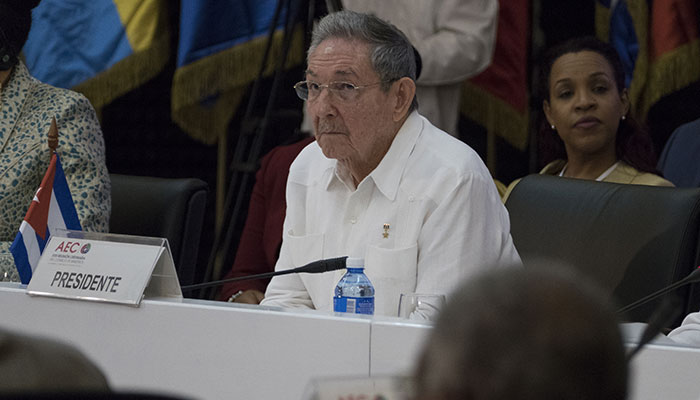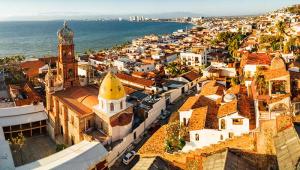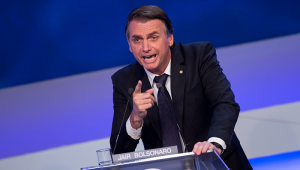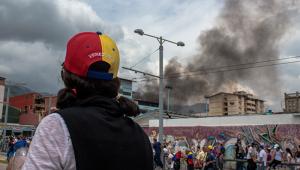web_raul-castro_shutterstock_599837570.jpg

Raul Castro is stepping down as the president of Cuba on 19 April
Cuba knows how to endure hurricanes. Only 10 Cubans died at the hands of the catastrophic Hurricane Irma last September – while 92 perished in the richer United States.
The Cuban way, it would seem, is to batten down the hatches and mix a mojito cocktail while the storm passes.
So as the Caribbean island prepares for its most important political transition since the 1959 Revolution, its policymakers are unlikely to be fazed by warnings of turbulence.
The national assembly is preparing to decide who will succeed President Raúl Castro, whose departure ends formal control by the “revolutionary generation” of guerrillas who fought in the Sierra Maestra.
At 86, Castro is retiring after 10 years in power, and on 19 April the assembly will elect his successor – with the front-runner being his protégé, Miguel Díaz-Canel, 57.
Whoever gets the job will come under immediate pressure to improve living standards as the cash-strapped island’s economy falters.
Macroeconomic performance has been disappointing under Castro – growth in per capita GDP and household consumption have stalled since 2006 – and life is characterised by shortages and rationing.
Public sector take-home pay is woefully inadequate and this has fuelled pilfering, the black market, moonlighting and a brain drain. Poverty is reappearing as cuts in subsidies – and rising prices – take their toll.
Productivity is faltering and lower commodity prices have driven down exports, worsening a balance of payments crisis.
Worst of all, Cuba is in debt – to the tune of $18bn (£12.7bn), 22% of GDP – having lambasted developing nations over decades for genuflecting to global financiers.
Cuba’s malaise has some obvious causes.
Its revolution produced a unique, socialist economy – engendering the eternal hostility of the US, which maintains a crippling economic embargo against the island to this day.
The embargo forced Cuba into a series of dependent relationships – most recently with Venezuela – and also helps to explain severe under-investment, reflected visibly in crumbling infrastructure.
But nor are Cuban policymakers blameless – and mismanagement has exacerbated long-term structural problems.
Small enterprises, for example, have been growing fast as a result of reforms since the 1990s, but while these had a fiscal intent – to reduce the public sector payroll – they were not matched by progress in tax collection, helping to explain hefty budget deficits.
There is no microfinance market, and while investors champ at the bit to put their money in Cuba – in 2017 it secured commitments of $2.3bn – they face numerous policy obstacles.
Cuba’s unique dual currency has distorted prices, kept state-owned firms uncompetitive, and depressed wages. Its financial sector, dominated by the monolithic central bank, needs a major overhaul.
Indeed, given the scale of Cuba’s problems, it is no surprise that commentators make dire predictions about its future.
The standard narrative is that its policymakers don’t know what to do and that a standoff is developing between reformists and hardliners.
With a large dollop of wishful thinking, this narrative confronts Díaz-Canel with a dilemma that is impossible to resolve: he will have to watch his back against Communist Party hardliners while reforming the economy in ways they will resist.
The inevitable outcome, so the narrative goes, will be a tearful end to the party – and a messy, overdue embrace of capitalism.
However, while this is an uncompromising, zero-sum perspective that we are all familiar with, it is outdated and ignores real signs of change.
First and foremost, Cuban policymakers acknowledge the need for reform: a private sector of 600,000 self-employed workers testifies to that.
First and foremost, Cuban policymakers acknowledge the need for reform: a private sector of 600,000 self-employed workers testifies to that.
In recent years, Havana has paid more attention to resolving its debt problems and has toned down its attacks on international financial institutions (IFIs) such as the IMF.
It has begun to open up, allowing the London Institute of Banking and Finance to provide professional training and, last year, joining the Central American Bank for Economic Integration (CABEI) and accepting help from the Andean Development Corporation (CAF).
Cuba has also had contact with US banks, and in May will host the Economic Commission for Latin America and the Caribbean (ECLAC).
Moreover, Cuba does not lack goodwill: in January, the European Union’s top diplomat visited, and Russia is trying to seize the opportunity.
The missing piece in this puzzle is policy: Havana needs to make a virtue of its mixed economy.
In a fascinating analysis, Richard Feinberg of the Brookings Institution argues that it can do this – without sacrificing its dignity – by building upon the three sectors already shaping a complex, diversified economy to create “tripartite-guided growth à la Cubana”.
This analysis implies that, first, Cuba needs to unleash the huge potential of its nascent private sector – taking individuals off the public payroll while empowering them to pay taxes.
Second, Cuba needs to consolidate its alliance with the foreign sector – and the runaway success of tourism shows how this can be done: arrivals rose from 2.2 million in 2006 to 4.7 million in 2017.
The role of foreign investment has risen rapidly up the agenda of Cuban policymakers and, while not without teething troubles, the Mariel Special Development Zone offers a model.
A step forward would be for Cuba to regain access to the IFIs. Despite what Havana may say, US opposition is not insurmountable: a clear majority at the IMF backs Cuban membership.
Finally, Cuba needs to reform its state to inject efficiency into public enterprises that have become a drag on the economy and to bring welfare into the 21st century by targeting it.
But for Cuba to make a virtue of its mixed economy, it must signal its intent.
It could start by addressing a habitual lack of transparency that prevents its reintegration with the IFIs. Havana has not released data on its international capital accounts or debt in years.
With transparency must come policy clarity: the new president has a generational opportunity to spell out clearly how a mixed economy can work.
While the Cuban government’s reflex is to control everything, modern states rely upon the self-compliance that comes with legal clarity: Havana can have its cake and eat it, retaining full control over a mixed economy indirectly through comprehensive, modern regulations.
None of this is easy, of course, and there are signs that reform has already posed political problems.
But Cuba’s system – forged with a strong moral compass through self-reliant isolation – makes this country uniquely capable of seizing the moment.
So while the usual suspects line up to forecast a hurricane blowing Raúl Castro’s successor off course, the reality is that with the right mix of mojito Cuba can not only ride out the storm, but build anew once it is over.














